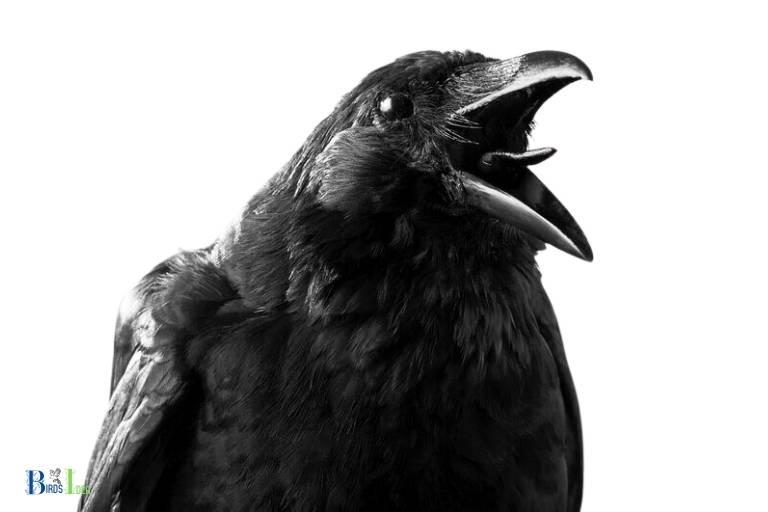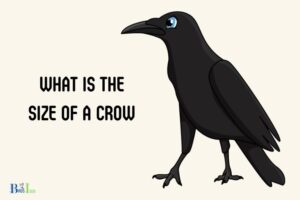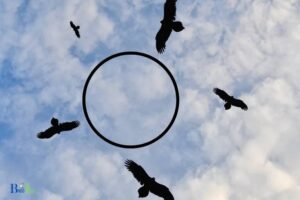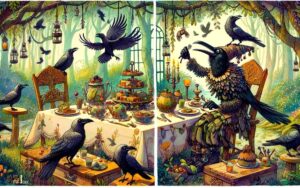What Does a Crow in Distress Sound Like? Loud, Harsh!
A crow in distress sounds like a series of loud, harsh, and frantic caws or screeches that are higher in pitch and more irregular than their typical calls.
When a crow is in distress or feels threatened, its vocalizations change to alert other crows or to scare off potential predators.
The distressed call is unmistakably different from the regular cawing and serves as a signal to other crows in the area.
Crows in distress have a unique, unmistakable call that can alert other crows or humans to their situation.
If you hear a crow in distress, it’s essential to approach the situation with caution, as the crow may be injured or protecting its territory from a potential threat.
4 Sounds: About Crow in Distress
| Sound | Description | Possible Cause of Distress |
| Alarm Call | Harsh, repetitive cawing | Predator nearby, threat to nest |
| Distress Call | Raspy, high-pitched caw or shriek | Injured, feeling cornered |
| Begging Call | Soft, nasal caw | Juvenile seeking food, attention |
| Scolding Call | Rapid series of caws, sometimes with clicks | Agitated, defending territory |
Key Takeaway

Five Facts About: Distressed Sounds of Crows
What Does A Crow In Distress Sound Like?
Description Of The Sound
Crows are intelligent creatures with unique ways of communicating with one another. When distressed, crows produce a distinct and harsh sound that is easy to recognize.
Here are some key characteristics of the sound:
- The crow’s distress call is a loud and raspy cawing sound.
- It often sounds more urgent and higher-pitched than a regular crow caw.
- The sound can vary slightly depending on the exact situation that is causing the crow distress.
Why Accurate Identification Is Important?
Accurately identifying the sound of a crow in distress can be useful for a few different reasons.
Here are some key points to keep in mind:
- Being able to recognize a crow’s distress call can help you understand when a crow is in danger or needs help. This, in turn, can enable you to take action to assist the bird.
- In some cases, crows may gather together and make a lot of noise if they feel threatened or are warning each other of danger. By understanding whether the sound is a distress call or something else, you can better interpret the situation.
- Finally, accurately identifying the sound of a crow can be helpful if you are a wildlife enthusiast or researcher. Understanding the nuances of crow behavior and communication is an important part of studying these fascinating birds.
With time and experience, you can develop a keen ear for these unique sounds and better understand these intelligent, complex creatures.
Environmental Factors That Influence Crow Calls
Have you ever wondered how a crow in distress sounds like? Crows are notorious for their noisy and raucous calls, but their distress calls are something else entirely.
Environmental factors play a critical role in shaping the different calls that crows make, including their distress calls.
We’ll explore how weather conditions, time of day, and geographic location affect crow calls.
Weather Conditions
Weather conditions have a significant influence on how crows behave and sound.
Here are some key points:
- During clear and calm weather, crows tend to be vocal and make more complex calls, including their territorial calls and other social calls.
- On rainy days, crows are usually quieter, and their calls tend to be shorter and simpler. It’s believed that this behavior is due to the reduced visibility and the fact that flying in inclement weather is more dangerous for crows.
- During high winds, crows are also quieter, and they tend to stay closer to the ground to avoid being blown away by strong gusts. You may hear more of their rattling and throaty calls during windy weather.
Time Of Day
The time of day also plays a crucial role in crow behavior and vocalizations.
Some key points to keep in mind are:
- Early mornings are when crows are usually their most vocal. This is because they are establishing their territories for the day, and they need to communicate with other crows in the area.
- Just before sunset, crows tend to gather in large numbers and form communal roosts. At this time, you may hear more of their flocking calls, which are usually high-pitched and shrill.
- During the night, crows are usually quiet and roost in large trees. However, they may occasionally make low, croaky calls while settling in for the night.
Geographic Area
Finally, the geographic area that crows inhabit also influences their calls.
Here are some key points:
- Crows living in urban areas tend to have a higher-pitched call than those living in rural areas. This is because city environments are generally louder, and crows need to make themselves heard above the noise.
- In some regions of the united states, crows have adapted their calls to mimic the calls of the local red-tailed hawk. By sounding like a predator, crows can scare away potential threats to their territory and food sources.
- In areas where there are fewer natural predators, crows tend to be quieter and less vocal overall. This is because they don’t need to compete as much for resources.
Crows’ calls are not only noisy but also highly influenced by environmental factors such as weather conditions, time of day, and geographic location.
Understanding these factors can help you identify and interpret the different types of calls that crows make, including their distress calls.
Types Of Crow Distress Calls
Crows are intelligent birds with complex communication systems. They use their calls to warn each other about potential dangers, claim territory, and communicate with family members.
Understanding crow vocalizations is important, including distress calls that alert others to potential danger.
Here are the three types of crow distress calls to listen out for:
Alarm Calls
- Alarm calls are the most common type of distress call you may hear from a crow. They are loud and sharp, and often repeated several times in quick succession.
- These calls are meant to alert other crows to potential dangers and can be heard from a long distance. Crows emit this call to warn others of predators such as hawks, eagles, and owls.
- The alarm call is also a way to scare off intruders like cats, dogs, or humans who are approaching their territory.
Begging Calls
- Crows also emit begging calls when they are in distress. These are usually softer and more drawn out than the alarm calls.
- Young crows in particular will make this call when they are hungry or feeling vulnerable. They are often made in response to adult crows arriving with food or help.
- If you hear a young crow making this sound, it may be best to leave it alone as the parents will likely return soon.
Aggressive Calls
- When crows are feeling threatened or attacked, they may emit aggressive calls. These calls are harsh and guttural and meant to scare off the offender.
- If you hear these calls, it may be a sign that there is a predator or unwanted human or animal in the area.
- The crows will often gather together, making more noise and swooping at the offender to encourage them to leave.
By understanding the types of crow distress calls, you can better interpret the birds’ cries, improve your communication with them, and ultimately appreciate their intelligent language.
Recognizing Distress Calls
If you’ve ever witnessed a crow in distress, you may have noticed that they sound quite different from their usual cawing noise.
It’s essential to recognize these calls as they can indicate that something is wrong, and the bird may need help.
Here’s what you need to know about recognizing distress calls, as well as other behaviors displayed by distressed crows.
Vocalizations
Crows use a wide range of vocalizations to communicate, and distress calls are just one of them.
The three most common types of distress calls that crows make are:
- Cawing: This is the most recognizable sound that crows make. However, when in distress, these caws tend to be short and rapid.
- A harsh, grating sound: This sound that’s reminiscent of a scream indicates intense pain or aggression.
- A high-pitched, whining “waaah, waaah”: This cry is typical of baby crows, but adults will make this type of sound when they are in severe distress.
Body Language
In addition to different vocalizations, crows’ body language can also indicate when they are in distress.
Watch out for these signs:
- Fluffed-up feathers: This is a sign that the crow is cold, scared or trying to make itself look bigger to appear more intimidating.
- Wing drooping: If one of a crow’s wings appears to be drooping or lower than the other, it could indicate an injury.
- Limping: Crows may have difficulty walking when they are injured and may instead hop or drag one foot while moving.
Other Behaviors To Look For
Apart from vocalizations and body language, there are a few other things to look for when trying to determine if a crow is in distress.
These include:
- Unnatural stillness: A distressed crow may be motionless or stay in one place for an extended period.
- Aggression: Crows may become more aggressive when they are in distress, especially if they feel threatened or cornered.
- Unusual feeding habits: If you notice a crow scavenging for food in an unusual place, it could be a sign that it’s not feeling well.
Knowing how to recognize distress calls and other behaviors is crucial for anyone who wants to help injured or distressed crows.
Keep an eye out for these signs, and if you encounter a bird in distress, contact a local wildlife rescue organization.
Crow Call Identification Resources
Have you ever heard a crow in distress? The sound of a distressed crow is unmistakable. It’s loud, harsh, and almost painful to the ears.
Crow calls can be useful to birdwatchers, researchers, and even homeowners who are concerned about the safety of their property.
We’ll discuss how to identify the different types of crow calls and where to find resources for bird identification.
Bird Identification Apps
Bird identification apps are an excellent resource for identifying crow calls and different bird species.
Here are some of the most popular bird identification apps:
- Merlin bird id: Merlin bird id is a free app that helps you identify birds by asking simple questions about their size, colour, and location. It includes a library of over 650 north american birds, including crows and ravens.
- Audubon bird guide: Audubon bird guide is another free app that offers a comprehensive bird identification database. It includes more than 800 north american bird species, with photos, audio recordings, and identification tips.
- Ibird: Ibird is a paid app that offers high-quality photos, illustrations, and detailed descriptions of more than 900 north american birds. It also includes bird calls and songs, making it an excellent resource for identifying crow calls.
Research Tools
When it comes to bird identification, there are many research tools available online.
Here are some resources you might find helpful:
- Cornell lab of ornithology: Cornell lab of ornithology is a non-profit organization dedicated to the study and conservation of birds. Their website includes an extensive library of bird sounds and calls, including those of crows and ravens.
- All about birds: All about birds is another website run by the cornell lab of ornithology. It offers detailed information on bird identification, including audio recordings of bird calls and songs.
- Ebird: Ebird is a citizen science project that collects bird observations from around the world. It’s a great resource for finding out where crows and other bird species are being spotted and what calls they’re making.
Identifying the sound of a crow in distress can be crucial for bird enthusiasts and homeowners alike.
Bird identification apps and online research tools can help you learn about the different types of crow calls and identify them when you hear them.
FAQ Of What Does A Crow In Distress Sound Like
What Is The Sound Of A Crow In Distress?
Why Do Crows Make Distress Calls?
How Can You Identify If A Crow Is In Distress?
What Should I Do If I Hear A Crow In Distress?
Are Crows The Only Birds That Make Distress Calls?
Conclusion
After researching the topic of crows in distress, it is clear that these birds make a variety of sounds to communicate their distress.
From the harsh cawing to the softer crooning, each sound carries its own meaning. Identifying these sounds and understanding their context can help humans better understand.
Whether it’s mimicking sounds or simply taking a few moments to listen to the world around us, there are many ways that we can connect with nature and learn from its inhabitants.
By paying attention to the signs of distress from crows and other animals, we can work to create a more harmonious relationship between humans and the natural world.
So, the next time you hear a crow in distress, take a moment to listen and learn. Together, we can make our world a better place for all creatures, great and small.






